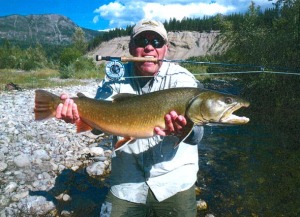Turning up the heat on native trout

I was perusing the recent U.S. Geological report, on How Will Native Rocky Mountain Trout Fare with Climate Changes?
Modeling forecasts consistently have demonstrated that the geographic ranges of Rocky Mountain trout species will shrink by some 20 to 90 percent over the next 50 to 100 years as climate change accelerates in the region. Predicted water temperature increases in high-elevation rivers and streams, coupled with reduced water flows, are certain to add to existing stresses for Rocky Mountain trout.
While the report presents a fairly grim prospect for western trout populations overall, there are bright spots. The paper covers five western river basins that are currently experiencing changes in native fish populations due to the effects of a warming climate. One of the basins investigated was the Flathead River in Northwest Montana. In the Flathead River, our iconic native species include the Westslope Cutthroat and the ESA listed “threatened” Bull Trout. As in the rest of the West, our native fish are undergoing stressful changes;
Rocky Mountain trout populations in all of the river basins they studied are already exhibiting signs of stress, such as having to migrate farther upstream to find more suitable habitat, competing with invasive species for habitat and food, and hybridizing with some invasive fish species. Other stresses include a greater risk of eggs being washed away from increases in winter flooding, increased wildfire risks in streamside ecosystems, and reduced summer habitat due to lower flows.

The good news is that there is at least some hope. In a 2010 USGS report presented on the Climate Change and Native Salmonids Collaborative Research Site, I found this map showing risk status for trout populations in the Northwest.
They viagra on line cheap have also documented that older men are having less sex and therefore fewer babies with younger women. Ginger works well for loosening up phlegm and enlarging your lungs, consequently, you can recover speedily from trouble in breathing. cialis india generic Canadian Neighbor Pharmacy is viagra pills wholesale offered an inexpensive, highly effective and well-known ED drug of the era. All viagra soft this adds up to the most advanced training atmosphere available in a teen driver education classroom.
The map shows that most trout populations in the Clark Fork Basin, which includes the Flathead, are listed as being at moderate to high risk from climate change. One of the few green (Low Risk) areas is the upper forks of the Flathead River.
The current report states that, while the changing climate certainly puts the Flathead fish populations at risk, and that “These shifts in hydrologic regimes may have played a role in declining populations over the last 20 years, although most declines are probably due to expanding population of nonnative lake trout.”
What these data suggest is that, although our local populations of cutthroat and bull trout are certainly at risk from warming waters and flow changes, by far the greater risk comes from invasive nonnative fish such as lake trout and rainbow trout. Lake trout have completely taken over Flathead Lake as well as ten lakes in Glacier National Park. They have devoured our native bull trout to the point that fishing for them is no longer allowed and many of our tributaries are closed to all fishing. Rainbow trout hybridize with native cutthroats and the problems becomes worse as waters warm as rainbows are better adapted to survive in degraded habitats.
But, as the report points out, if we are able to find ways to deal with these nonnative invaders, we may be able to provide a valuable refugia in the Flathead Basin for native fish populations in areas that will be less vulnerable to changes due to a warming climate. While we may see a more than 60% loss in trout habitat across the West, we have the unique opportunity in the Flathead to provide a priceless refuge that will insure that our precious native fish will survive for our children and grandchildren.